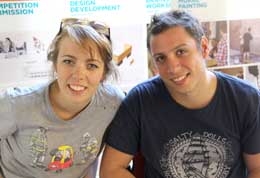18 April 2012
 A collaboration between University of South Australia architecture students, street artists, the Integrated Design Commission and the Service to Youth Council is bringing the plight of homeless youth right into the heart of Adelaide this month through a major installation now in place on North Terrace.
A collaboration between University of South Australia architecture students, street artists, the Integrated Design Commission and the Service to Youth Council is bringing the plight of homeless youth right into the heart of Adelaide this month through a major installation now in place on North Terrace.
The project will be launched today at 11am by Minister for Youth, Ian Hunter to mark Youth Homelessness Day.
While it may be quite hidden from general view, each night in Adelaide more than 2900 young people find themselves homeless.
The North Terrace installation is designed to put the issue on the map, on our streetscape and in our consciousness.
Known as Project Tag, the concept for the installation was born out of the success of last year’s youth homelessness awareness competition, Reality Checkpoint, which asked UniSA art, architecture and design students to consider homelessness and its impact on young people in designing an installation that would put the issue on the agenda.
The winners of that competition were funded in-kind by Jamie McClurg, director of Commercial and General to make their vision a reality. Their work has been undertaken through UniSA’s Matchstudio, a research and professional practice studio established to support students’ transition to the working world.
UniSA architecture students leading the project, Ellen Buttrose and John Pagnozzi (pictured above), said the work offered some important learning challenges architecturally, but also challenged their thinking around the sensitive issue of youth homelessness and helped to exercise all the skills required to manage a large-scale design projects involving input from various groups.
The mural for the 16m x 8m x 6m installation was entirely informed by input from young clients of the Service to Youth Council and completed under the direction of street artist Jason Koen.
“As part of the project we spent a lot of time thinking about how the design of the installation could best start a conversation about youth homelessness but a conversation that was very inclusive of young people themselves,” Buttrose said.
“There is a great deal of stigma attached to homelessness but we wanted to look at the issue in a more personal way. We wanted to take it out of the context of an ‘issue’ and bring it back to the point where we acknowledge that homelessness happens to people, it does not define them.”
The installation which can be walked around and through, proffers the unfinished sentence “I need a place that…” and there is a vast blackboard section where people can write the end to that sentence from their own perspective. The designers say this participation in the work was central to ensuring it would operate to empower young people.
One of the contributors to the project UniSA College Foundation Studies student, Lorenzo Kirk, has a special understanding of the importance of the work. Working with street artist Jason Koen to help design the street facing artwork for the installation, Kirk was able to bring personal experiences to the visualisation of homelessness.
Unexpectedly homeless for a few months Kirk, says he understands how the stereotype of homelessness can weigh young people down.
“I think the installation is an opportunity for people to get a better understanding of youth issues and I hope it will lead to people thinking about the problem more deeply and even motivate them to help out,” he said.
Dr Angelique Edmonds, Engagement Leader at the Integrated Design Commission says the Commission has been delighted to be involved in the project.
“The outcomes of this collaboration demonstrate the capacity of design to contribute meaningfully to the social, economic and environmental life of the city,” Dr Edmonds said.
“I think it the project has underlined the vital importance of young people's voice in shaping the fabric of the city and the innovation young designers bring to addressing the social issues of our time by asking how public space can facilitate social advocacy.
“In this case design has been used as a tool to facilitate community building. The Project Tag design explores how public space could be re-imagined as a space for an inclusive conversation.”
Media contact
- Michèle Nardelli office (08) 8302 0966 mobile 0418 823 673 email michele.nardelli@unisa.edu.au




